Modeling and Control of Dynamic Stall Loads on a Smart Airfoil at Low Reynolds Number
Abstract
:1. Introduction
2. Experimental Setup
3. Steady and Unsteady Measurements for the Clean NACA 643-618 Airfoil
4. The Modified ONERA Dynamic Stall Model for Smart Airfoils
5. Modeling Unsteady Loads on Smart NACA 643-618 Airfoil
6. Control of Unsteady Loads on Smart NACA 643-618 Airfoil
7. Conclusions
Author Contributions
Funding
Data Availability Statement
Conflicts of Interest
Appendix A. Measured and Modeled Unsteady Aerodynamic Loads



SIMULINK Systems of the PID Control Scheme
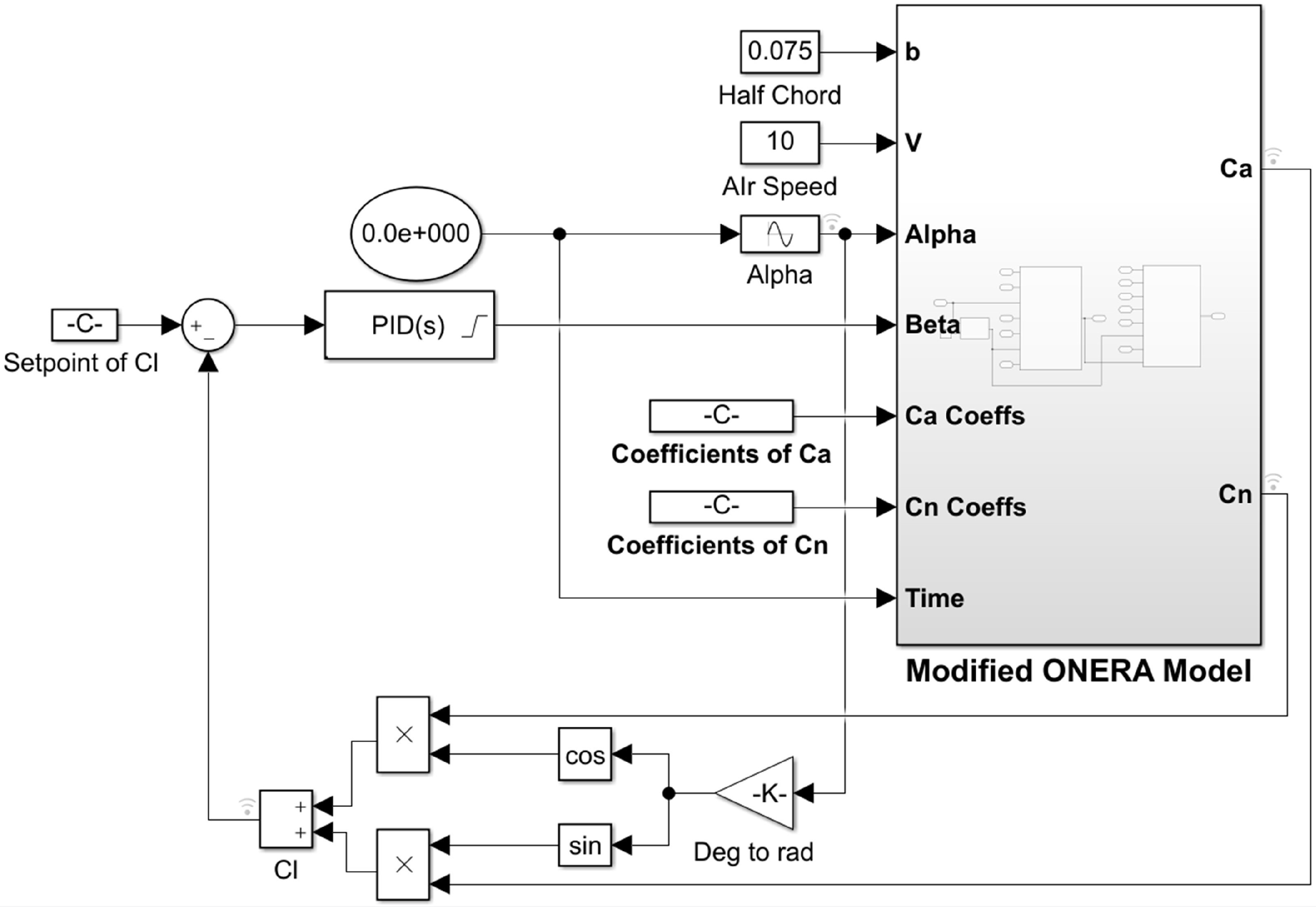

References
- Theodorsen, T. General Theory of Aerodynamic Instability and the Mechanism of Flutter; Technical Report 496; NACA: Washington, DC, USA, 1949. [Google Scholar]
- Shipley, D.; Miller, M.; Robinson, M.; Luttges, M.; Simms, D. Evidence that Aerodynamic Effects, Including Dynamic Stall, Dictate HAWT Structural Loads and Power Generation in Highly Transient Time Frames; Technical Report TP-441-7080; National Renewable Energy Lab.: Golden, CO, USA, 1994. [Google Scholar]
- Schreck, S.; Robinson, M.; Hand, M.; Simms, D. HAWT dynamic stall response asymmetries under yawed flow conditions. Wind Energy 2000, 3, 215–232. [Google Scholar] [CrossRef] [Green Version]
- Carr, L.W. Progress in analysis and prediction of dynamic stall. J. Aircr. 1988, 25, 6–17. [Google Scholar] [CrossRef]
- Robinson, M.; Galbraith, R.; Shipley, R.; Miller, M. Unsteady aerodynamics of wind turbines. In Proceedings of the 33rd Aerospace Sciences Meeting and Exhibit, Reno, NV, USA, 9–12 January 1995. [Google Scholar]
- Barlas, T.K.; Van Kuik, G.A. Review of state of the art in smart rotor control research for wind turbines. Prog. Aerosp. Sci. 2010, 46, 1–27. [Google Scholar] [CrossRef]
- Leishman, J.G. Unsteady lift of a flapped airfoil by indicial concepts. J. Aircr. 1994, 31, 288–297. [Google Scholar] [CrossRef]
- Hariharan, N.; Leishman, J.G. Unsteady aerodynamics of a flapped airfoil in subsonic flow by indicial concepts. J. Aircr. 1996, 33, 855–868. [Google Scholar] [CrossRef]
- Andersen, P.B.; Gaunaa, M.; Bak, C.; Buhl, T.; Poulsen, N.K. Advanced Load Alleviation for Wind Turbines Using Adaptive Trailing Edge Flaps: Sensoring and Control. Ph.D. Thesis, Risø National Laboratory for Sustainable Energy, Roskilde, Denmark, 2010. [Google Scholar]
- Andersen, P.B.; Gaunaa, M.; Bak, C.; Hansen, M.H. A dynamic stall model for airfoils with deformable trailing edges. Wind Energy 2009, 12, 734–751. [Google Scholar] [CrossRef] [Green Version]
- Medina, A.; Ol, M.V.; Williams, D.R.; An, X.; Hemati, M. Modeling of conventional flaps at high deflection-rate. In Proceedings of the 55th AIAA Aerospace Sciences Meeting, Grapevine, TX, USA, 9–13 January 2017. [Google Scholar]
- Goman, M.; Khrabrov, A. State-space representation of aerodynamic characteristics of an aircraft at high angles of attack. J. Aircr. 1994, 31, 1109–1115. [Google Scholar] [CrossRef]
- Raiola, M.; Discetti, S.; Ianiro, A.; Samara, F.; Avallone, F.; Ragni, D. Smart rotors: Dynamic-stall load control by means of an sctuated flap. AIAA J. 2017, 56, 1388–1401. [Google Scholar] [CrossRef]
- Ahaus, L. An Airloads Theory for Morphing Airfoils in Dynamic Stall with Experimental Correlation. Ph.D. Thesis, Washington University, St. Louis, MO, USA, 2010. [Google Scholar]
- Petot, D. Differential equation modeling of dynamic stall. Rech. Aerosp. Ed. 1989, 5, 59–72. [Google Scholar]
- Mulleners, K.; Raffel, M. The onset of dynamic stall revisited. Exp. Fluids 2012, 52, 779–793. [Google Scholar] [CrossRef] [Green Version]
- Bak, C.; Gaunaa, M.; Andersen, P.B.; Buhl, T.; Hansen, P.; Clemmensen, K. Wind tunnel test on airfoil Risø-B1-18 with an trailing edge flap. Wind Energy 2010, 13, 207–219. [Google Scholar] [CrossRef]
- Gerontakos, P.; Lee, T. PIV study of flow around unsteady airfoil with dynamic trailing-edge flap deflection. Exp. Fluids 2008, 45, 955. [Google Scholar] [CrossRef]
- Frederick, M.; Kerrigan, E.; Graham, J. Gust alleviation using rapidly deployed trailing-edge flaps. J. Wind Eng. Ind. Aerodyn. 2010, 98, 712–723. [Google Scholar] [CrossRef]
- Velte, C.M.; Mikkelsen, R.F.; Sørensen, J.N.; Kaloyanov, T.; Gaunaa, M. Closed loop control of a flap exposed to harmonic aerodynamic actuation. In Proceedings of the The Science of Making Torque from Wind 2012: 4th Scientific Conference, Crete, Greece, 27–30 July 2012. [Google Scholar]
- Gaunaa, M.; Andersen, P.B. Load reduction using pressure difference on airfoil for control of trailing edge flaps. In Proceedings of the 2009 European Wind Energy Conference and Exhibition, Marseille, France, 16–19 March 2009. [Google Scholar]
- Zhu, W.J.; Shen, W.Z.; Sørensen, J.N. Numerical investigation of flow control feasibility with a trailing edge flap. J. Phys. Conf. Ser. 2014, 524, 1–11. [Google Scholar] [CrossRef]
- Mohamed, A.; Wood, D.H. Modeling dynamic loads on oscillating airfoils with emphasis on dynamic stall vortices. Wind Energy 2021. [Google Scholar] [CrossRef]
- Mack, S.; Brehm, C.; Heine, B.; Kurz, A.; Fasel, H. Experimental investigation of separation and separation control on a laminar airfoil. In Proceedings of the 4th Flow Control Conference, Seattle, WA, USA, 23–26 June 2008. [Google Scholar]
- Gross, A.; Fasel, H. Self-adaptive closed-loop control of low-Reynolds number laminar separation. In Proceedings of the 25th AIAA Applied Aerodynamics Conference, Miami, FL, USA, 25–28 June 2007. [Google Scholar]
- Plogmann, B.; Mack, S.; Fasel, H. Experimental investigation of open-and closed-loop control for airfoil under low Reynolds number conditions. In Proceedings of the 39th AIAA Fluid Dynamics Conference, San Antonio, TX, USA, 22–25 June 2009. [Google Scholar]
- Narasimha, R.; Prasad, S. Leading edge shape for flat plate boundary layer studies. Exp. Fluids 1994, 17, 358–360. [Google Scholar] [CrossRef]
- Granlund, K.; Ol, M.; Garmann, D.; Visbal, M.; Bernal, L. Experiments and computations on abstractions of perching. In Proceedings of the 28th AIAA Applied Aerodynamics Conference, Chicago, IL, USA, 28 June–1 July 2010. [Google Scholar]
- NATO. Extensions of Fundamental Flow Physics to Practical MAV Aerodynamics; Technical Report AVT-202; NATO: Washington, DC, USA, 2016. [Google Scholar]
- ISO. Guide to Expression of Uncertainty in Measurement; Technical Report JCGM 100; ISO: Geneva, Switzerland, 1995. [Google Scholar]
- Mohamed, A.S.A. Modeling and Control of Dynamic Stall Loads on Smart Airfoil. Ph.D. Thesis, Schulich School of Engineering, University of Calgary, Calgary, AB, Canada, 2020. [Google Scholar]
- Barlow, J.B.; Rae, W.H.; Pope, A. Low-Speed Wind Tunnel Testing; Wiley-Interscience: Hoboken, NJ, USA, 1999. [Google Scholar]
- Mueller, T.J.; Batil, S.M. Experimental studies of separation on a two-dimensional airfoil at low Reynolds numbers. AIAA J. 1982, 20, 457–463. [Google Scholar] [CrossRef]
- Heine, B.; Mack, S.; Kurz, A.; Gross, A.; Fasel, H. Aerodynamic scaling of general aviation airfoil for low Reynolds number application. In Proceedings of the 38th Fluid Dynamics Conference and Exhibit, Seattle, WA, USA, 23–26 June 2008. [Google Scholar] [CrossRef]
- Simons, M. Model Aircraft Aerodynamics; Nexus Special Interests: Hemel Hempstead, UK, 1999. [Google Scholar]
- Bousman, W.G. Evaluation of airfoil dynamic stall characteristics for maneuverability. J. Am. Helicopter Soc. 2001, 46, 239–250. [Google Scholar] [CrossRef] [Green Version]
- Shih, C.; Lourenco, L.M.; Krothapalli, A. Investigation of flow at leading and trailing edges of pitching-up airfoil. AIAA J. 1995, 33, 1369–1376. [Google Scholar] [CrossRef]
- McCroskey, W.J. The Phenomenon of Dynamic Stall; Technical Report A-8464; NASA: Mountain View, CA, USA, 1981. [Google Scholar]
- Leknys, R.; Arjomandi, M.; Kelso, R.; Birzer, C. Dynamic stall flow structure and forces on symmetrical airfoils at high angles of attack and rotation rates. J. Fluids Eng. 2019, 141, 051104. [Google Scholar] [CrossRef]
- Truong, K.V. Modeling aerodynamics, including dynamic stall, for comprehensive analysis of helicopter rotors. Aerospace 2017, 4, 21. [Google Scholar] [CrossRef] [Green Version]
- Leishman, J.G. Principles of Helicopter Aerodynamics; Cambridge University Press: Cambridge, UK, 2006. [Google Scholar]
- Lee, T.; Gerontakos, P. Investigation of flow over an oscillating airfoil. J. Fluid Mech. 2004, 512, 313–341. [Google Scholar] [CrossRef]
- Carta, F.O. Effect of unsteady pressure gradient reduction on dynamic stall delay. J. Aircr. 1971, 8, 839–841. [Google Scholar] [CrossRef]
- Lorber, P.F.; Carta, F.O. Airfoil dynamic stall at constant pitch rate and high Reynolds number. J. Aircr. 1988, 25, 548–556. [Google Scholar] [CrossRef]
- McCroskey, W.J.; Carr, L.W.; McAlister, K.W. Dynamic stall experiments on oscillating airfoils. AIAA J. 1976, 14, 57–63. [Google Scholar] [CrossRef]
- Mueller-Vahl, H.; Strangfeld, C.; Nayeri, C.; Paschereit, C.; Greenblatt, D. Thick airfoil deep dynamic stall and its control. In Proceedings of the 51st AIAA Aerospace Sciences Meeting including the New Horizons Forum and Aerospace Exposition, Grapevine, TX, USA, 7–10 January 2013; p. 854. [Google Scholar]
- Brendel, M.; Mueller, T.J. Boundary-layer measurements on an airfoil at low Reynolds numbers. J. Aircr. 1988, 25, 612–617. [Google Scholar] [CrossRef]
- Yang, Z.; Igarashi, H.; Martin, M.; Hu, H. An experimental investigation on aerodynamic hysteresis of a low-Reynolds number airfoil. In Proceedings of the 46th AIAA Aerospace Sciences Meeting and Exhibit, Reno, NV, USA, 7–10 January 2008. [Google Scholar]
- Williams, D.R.; Reißner, F.; Greenblatt, D.; Müller-Vahl, H.; Strangfeld, C. Modeling lift hysteresis on pitching airfoils with a modified Goman–Khrabrov model. AIAA J. 2016, 55, 403–409. [Google Scholar] [CrossRef]
- Modarres, R.; Peters, D.A.; Gaskill, J. Dynamic stall model with circulation pulse and static hysteresis for NACA 0012 and VR-12 airfoils. J. Am. Helicopter Soc. 2016, 61, 1–10. [Google Scholar] [CrossRef]
- Sung, S.W.; Lee, J.; Lee, I.B. Process Identification and PID Control; John Wiley & Sons: Hoboken, NJ, USA, 2009. [Google Scholar]


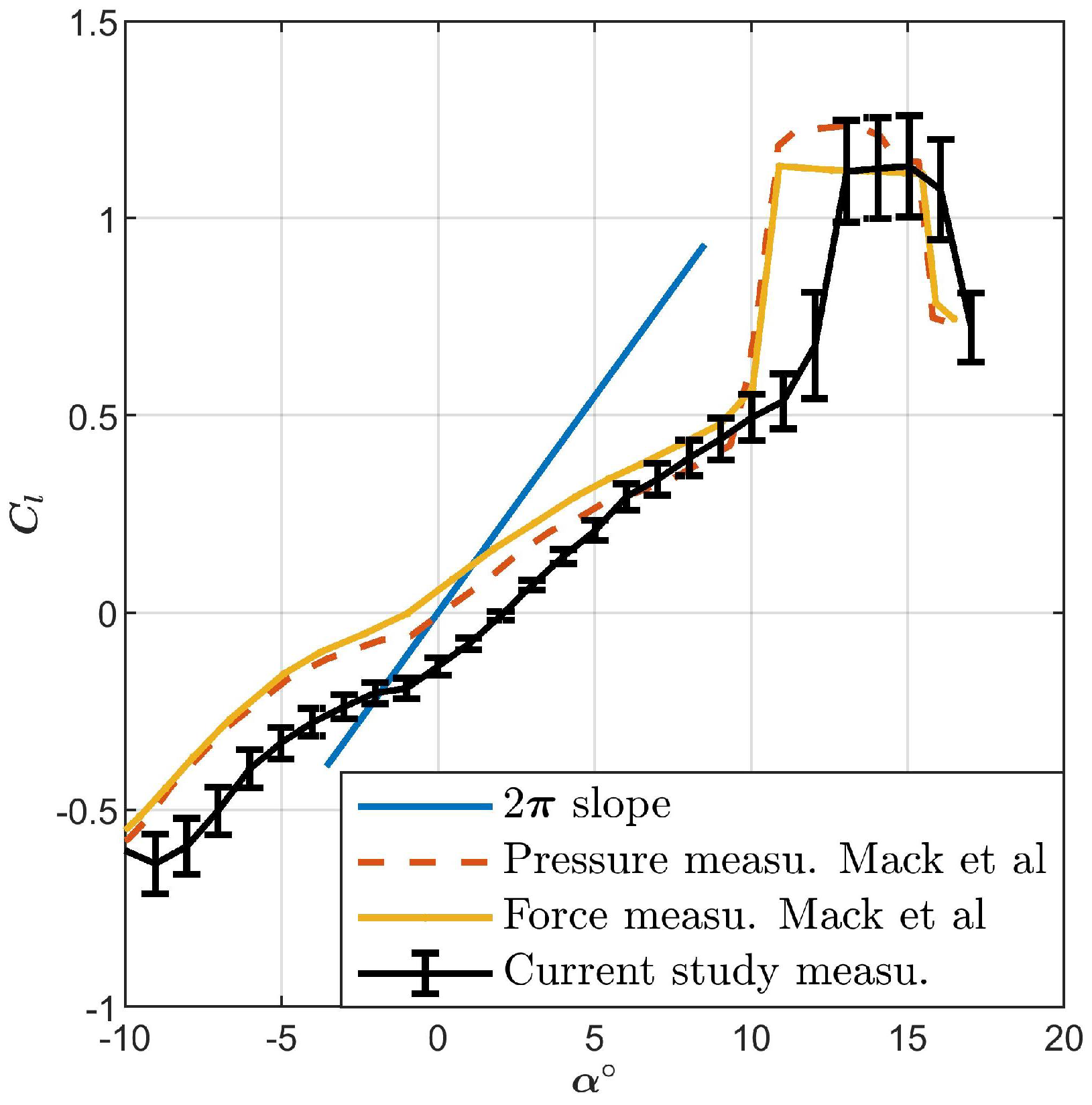





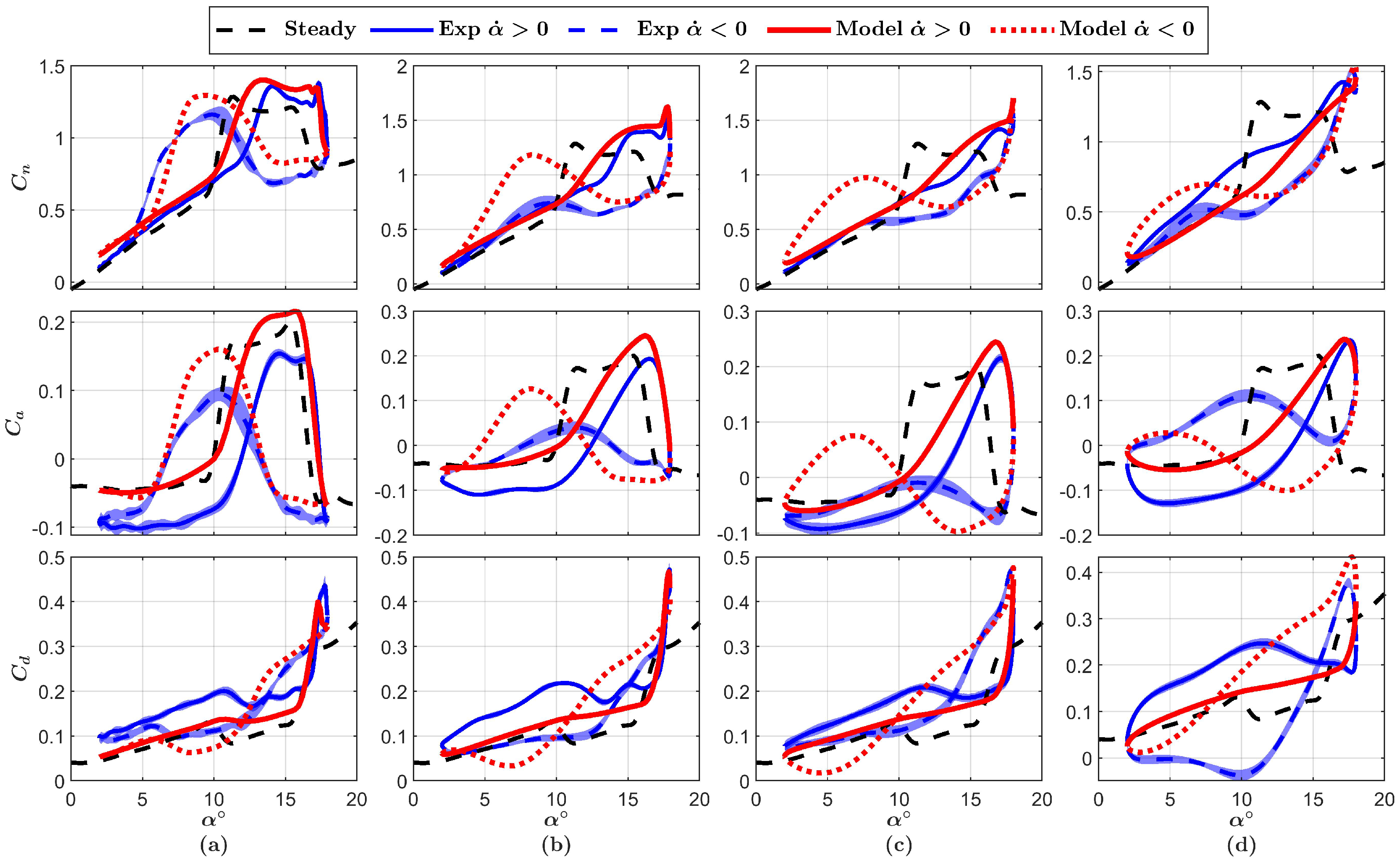

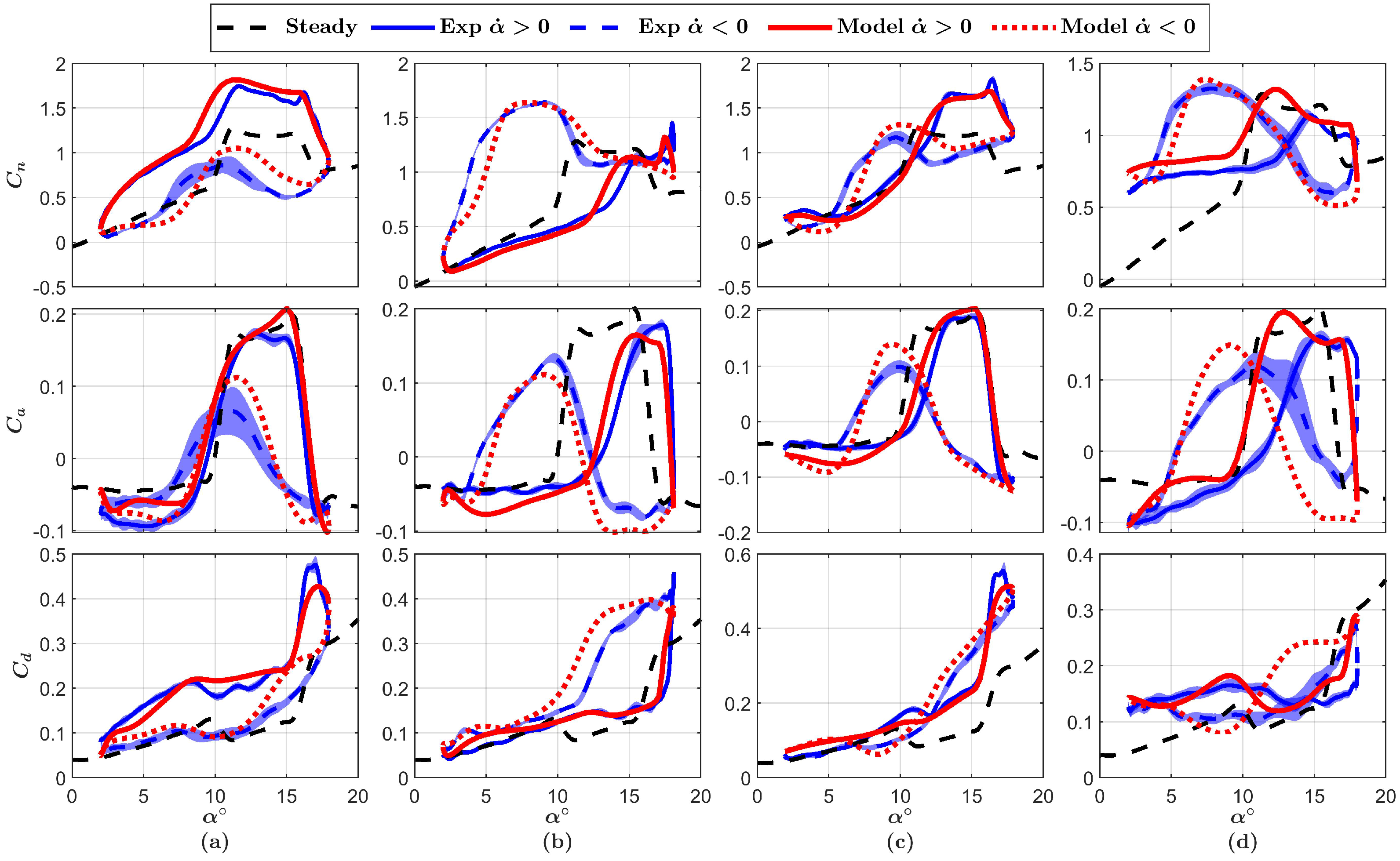
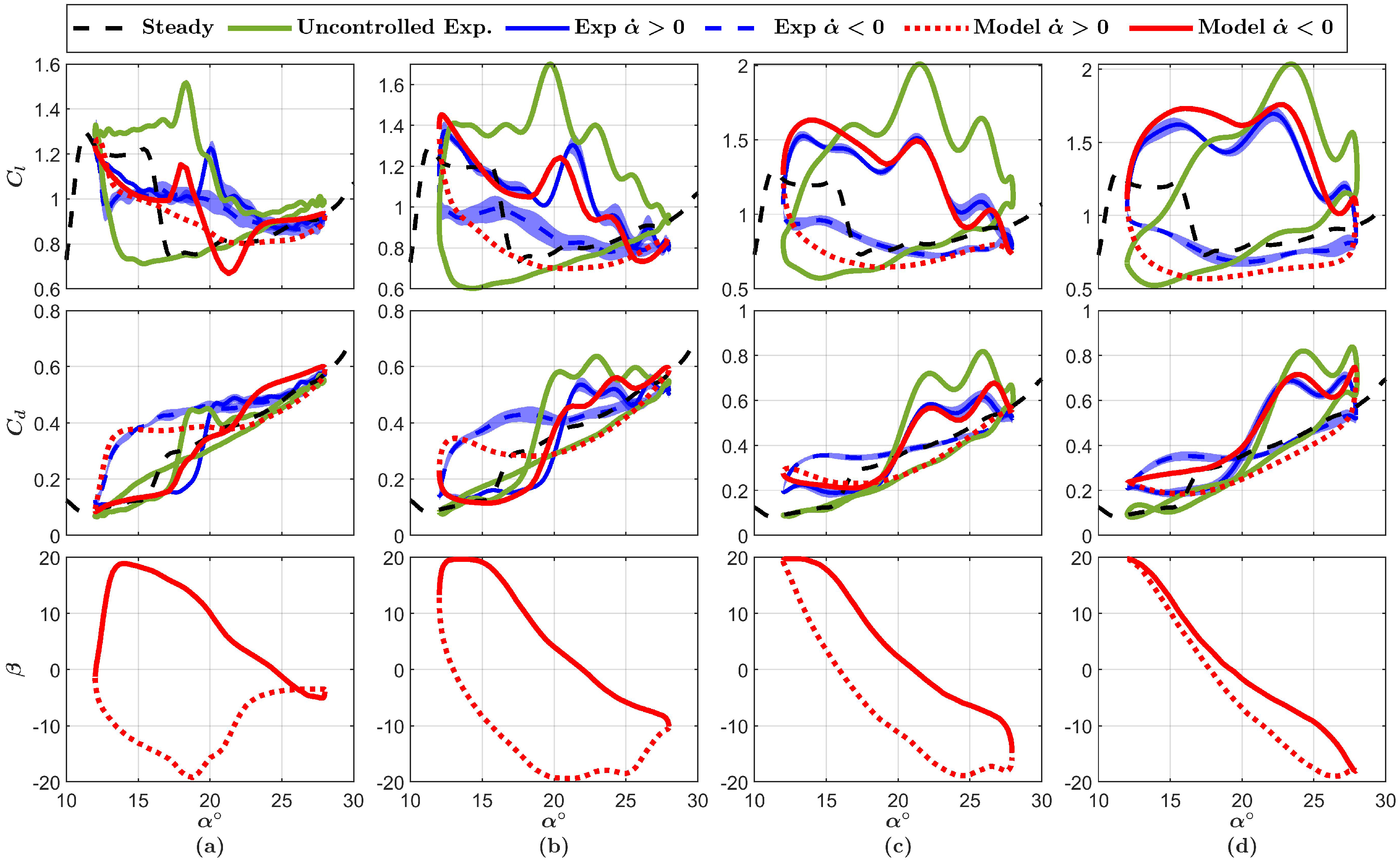
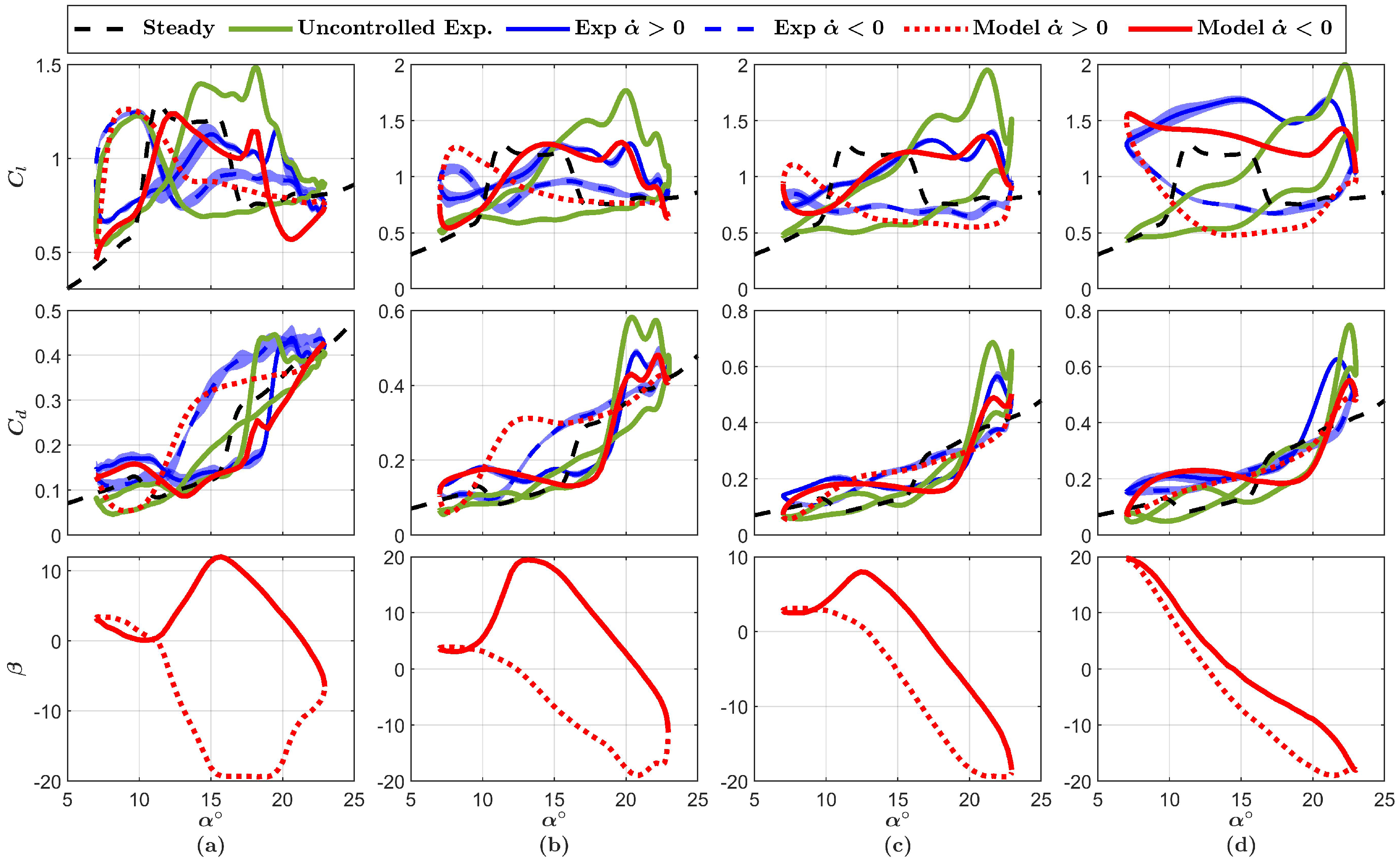

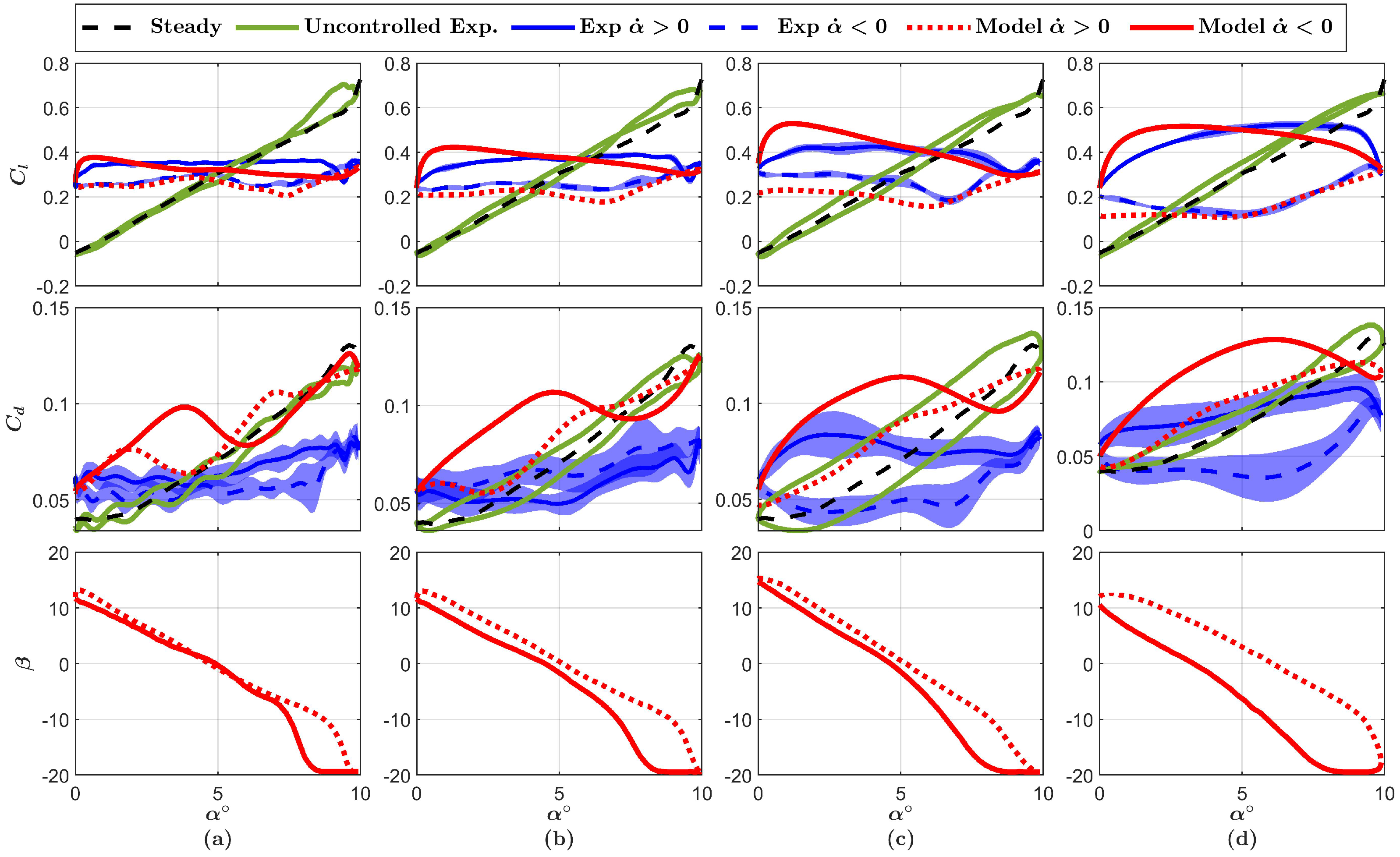

| Coefficient | |||||||||
|---|---|---|---|---|---|---|---|---|---|
| 0.25 | 0.6 | 0.2 | 0.1 | 3.5 | 3 | - | - | - | |
| 0.25 | 0.6 | 0.2 | 0.1 | −2.3 | 10 | 10 | 0.4 | 0.3 |
Publisher’s Note: MDPI stays neutral with regard to jurisdictional claims in published maps and institutional affiliations. |
© 2021 by the authors. Licensee MDPI, Basel, Switzerland. This article is an open access article distributed under the terms and conditions of the Creative Commons Attribution (CC BY) license (https://creativecommons.org/licenses/by/4.0/).
Share and Cite
Mohamed, A.; Wood, D.; Pieper, J. Modeling and Control of Dynamic Stall Loads on a Smart Airfoil at Low Reynolds Number. Energies 2021, 14, 4958. https://doi.org/10.3390/en14164958
Mohamed A, Wood D, Pieper J. Modeling and Control of Dynamic Stall Loads on a Smart Airfoil at Low Reynolds Number. Energies. 2021; 14(16):4958. https://doi.org/10.3390/en14164958
Chicago/Turabian StyleMohamed, Ayman, David Wood, and Jeffery Pieper. 2021. "Modeling and Control of Dynamic Stall Loads on a Smart Airfoil at Low Reynolds Number" Energies 14, no. 16: 4958. https://doi.org/10.3390/en14164958







